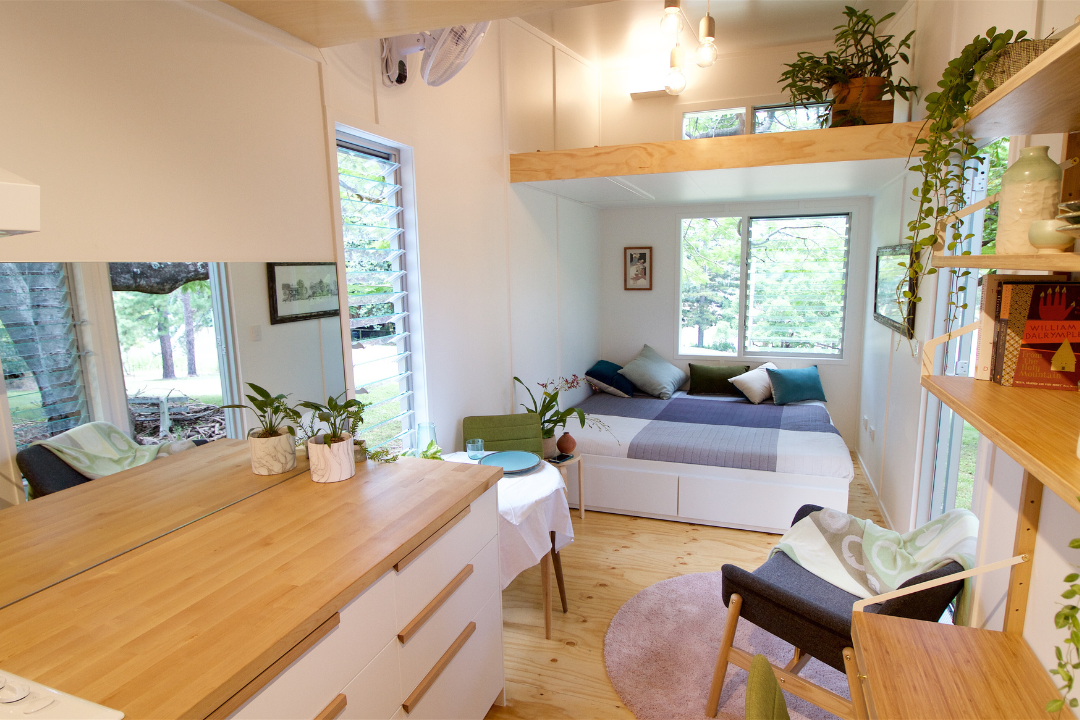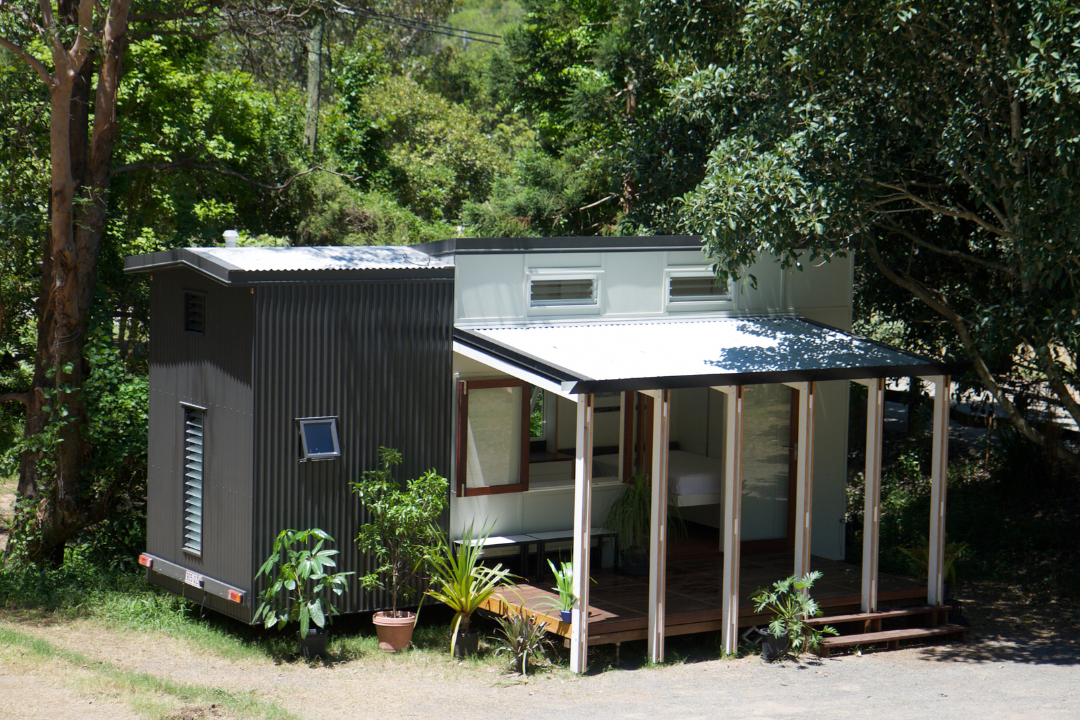Written by Professor Paul Burton, Cities Research Institute, Griffith University
While its fair to say that public interest in tiny houses continues to grow in Australia and some other countries of the global north, the number of people actually choosing to live in them remains small in comparison. This doesn’t make tiny housing a fad that will soon blow over, but equally it isn’t something that is going to solve the current housing crisis. So, what should we make of it? The panel discussion held at HOTA as part of Gold Coast Open House 2023 helped shed some light on the experience of tiny house living as well as the opportunities it presents and challenges it faces. But I’d like to share some thoughts on the matter, drawing on work done with my colleague and panellist, Dr Heather Shearer. We’ve looked at research on this from around the world, carried out a survey of local government planners in Australia to find out how they go about regulating tiny homes, and spoken in more detail with a small sample of those planners.
The first thing to note though, is that most people around the world, especially in the global south, live in homes that would be considered tiny by Australian standards. And second, is that contemporary expectations and housing standards in Australia are probably not those of our parents and certainly not those of our grandparents. A few years ago, the median floor size of a newly constructed dwelling in Australia was greater than in the USA. So, for a while we trumped them in building MacMansions, but normality has returned and in this respect they have indeed made America great again! While this is not the main cause of our contemporary housing crisis, part of the problem does lie in the unwillingness or perhaps inability of the market to deliver a wider range of new homes that would occupy what planners and architects call the ‘missing middle’ between single or maybe two-storey detached dwellings on the fringes of our cities and smaller apartments in towers in more central locations.
The COVID-19 pandemic forced many of us to think more seriously than we had done for some time about where and how we wanted to live. Some decided that city life was no longer very attractive, especially those who lived in the outer suburbs of our cities and were expected to commute into a CBD office every day. Some took the opportunity to make a tree or sea change to places that offered a more congenial environment, and some took the opportunity to review the amount and the quality of the space needed to live a good life or perhaps a more affordable life.
Many also reconsidered the benefits and the costs of multi-generational living, prompted sometimes by the return of adult sons and daughters – prodigal or otherwise – who needed a safe haven during the pandemic. Many boomers explored ways in which elderly parents might be able to live with their children and even grandchildren in ways that provided for and respected the autonomy expected by each generation.



So, for various reasons, many have been thinking about where and how to live in ways that don’t fit neatly into the two dominant ends of the housing typology spectrum and are exploring missing middle alternatives. Again, some look for little more than the ability to have a nicely designed granny flat in their backyard, whether or not for granny herself, or for the kids of whatever age or even someone who isn’t a member of the household and is willing to pay rent. Our research suggests that local planning authorities are reviewing their plans and policies to ensure that the ways these are regulated are up to date, fit for purpose and don’t reflect the priorities of earlier epochs, and this should be welcomed.
On the other hand, there are some attracted by a more mobile lifestyle and the opportunities offered by a tiny house on wheels that can be hitched to your car and moved whenever you need. Typically, these tiny houses are treated like caravans by our regulators. They need to comply with the relevant road rules on height and width for example, but they are not classed as dwellings and so fall outside the scope of the Building Code of Australia. Local planners become interested in them – often because of complaints from neighbours – if they are lived in for more than a short period of time, especially if they’re parked in a suburban driveway. Gaining approval to use a block of land as a legitimate park for a number of tiny houses on wheels, even if the landowner is willing and able to provide the facilities for these THOWs to be powered, supplied with water and wastewater treatment and garbage collection, is an altogether different ballgame. This takes a lot of time and fees to propose and have assessed, with limited chances of success. But, when needs must, we will do this. In East Lismore, North Coast Community Housing is managing a site with 52 temporary, prefabricated homes for up to 200 people affected by the 2022 floods. The scale of the challenge to house locals who have lost their homes is such that this temporary village is full and has a waiting list and there are several similar villages across the region.
What can we learn from these examples and emerging trends? In times of crisis, we can and must consider new ways of doing things, and ways of living. Previously these might have been seen as faddish, the preserve of fringe dwellers or even as un-Australian, forgetting that in the words of Bill Garner, colonial Australia was born in a tent. The current housing crisis is of course not limited to places devasted by floods like Lismore; it is affecting inner and outer city suburbs, remote and regional communities and the small towns beloved by tree and sea changers. Nor is homelessness and acute housing stress confined to those with serious mental and physical health problems, or those without a job, although people in these circumstances are continuing to suffer. Increasingly, it is affecting single people and couples in reasonably paid, full-time employment, including those we call key workers.
So, desperate times call not for desperate measures, but for serious and thoughtful consideration of all options for improving the supply of well-designed, well-constructed and well-located homes that are affordable to most people. This should include looking carefully at the opportunities for living smaller: in secondary dwellings and granny flats; in tiny houses on wheels; and in small-lot townhouses. Of course, not everyone wants to live this way but for those looking to trade floorspace for high-quality design and the imaginative use of space, we should make sure we haven’t put any outdated and unnecessary regulatory hurdles in their way.
I look forward to being shown around some excellent tiny homes of all types at an Open House in the not-too-distant future.
Image credit: Andrew Carter
WANT TO EXPLORE NEW OPPORTUNITIES IN CITIES RESEARCH?
The Griffity University Cities Research Institute works collaboratively with innovative companies, community groups, and governments at all levels to carry out new research that addresses real-world issues such as those facing cities like the Gold Coast.
If you’d like to find out more about the current research of the Institute, or discuss new research opportunities, get in touch with me at p.burton@griffith.edu.au.
